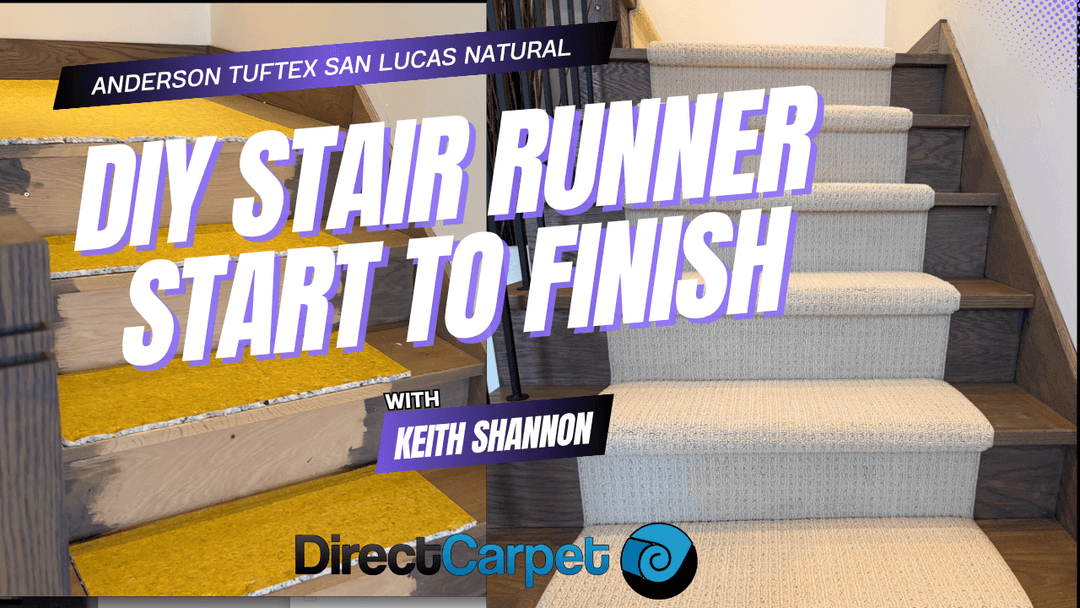Best Stair Runner Installation Techniques and How to Use Them

Struggling with stair runner installation? Discover the “best stair runner installation techniques and how to use them” in this comprehensive guide. Close the gap between frustration and a beautifully finished staircase with practical advice on material selection, precise cutting, secure stapling, and more, without overwhelming details or hard sales. Get ready to conquer every step of the installation confidently.
Key Takeaways
-
Get the right stair runner by considering the material (e.g., wool, synthetic fibers, natural fibers, etc.) for durability and ease of cleaning; choose small-scale, non-precise patterns to avoid visually distorted looks.
-
Measure your stairs meticulously for tread depth, riser height, and count; for fitting, leave about 3-4 inches of space on each side of the runner for a nice visual balance.
-
Proper installation includes preparing the stairs, cutting and placing carpet padding correctly, using the right stapling techniques, joining runners seamlessly, and implementing cleaning and maintenance practices.
Choosing the Right Stair Runner

Selecting the appropriate stair runner is a crucial initial step in ensuring a successful installation. It involves finding a harmonious balance between visual appeal and practicality, taking into account elements such as material, design, longevity, comfortability, and maintenance.
It is important to carefully consider all aspects when making your decision on the best option for your stairs. This includes not only choosing an appealing pattern or texture, but also keeping in mind its durability over time as well as how easy it will be to clean and maintain for optimal use on the staircase.
Material Options
The material selected for a stair runner can greatly impact its longevity and maintenance. Some suitable options include:
-
Wool
-
Synthetic fibers such as nylon or polyester
-
Natural materials like sisal or seagrass
In particular, synthetic blends like polyester and nylon are often preferred due to their durability and ease of upkeep, making them ideal choices for areas with heavy foot traffic.
Pattern Selection
Choosing the right stair runners involves careful consideration of various factors, one of which is selecting an appropriate pattern. To achieve a visually appealing finish, opt for abstract or floral designs that do not require precise alignment. It should be noted that geometric patterns may appear distorted on stairs, especially with curved ones. It is recommended to choose small-scale patterns as they are less likely to look uneven when placed on stair bends.
While traditional styles are often preferred for their timeless charm in terms of staircase decor choices, seeking guidance from design professionals can also help you find the perfect fit for your specific needs and preferences.
Measuring Your Stairs for the Perfect Fit

It is essential to achieve the perfect fit for your stair runner. A poorly sized runner can be both unattractive and pose a danger of tripping. How do you ensure that it fits just right? The key lies in accurate measurements of the depth and height of each step, as well as counting the number of treads and risers.
To guarantee an ideal fit, pay attention to these specific details when installing your stair runner. Take precise measurements for all aspects of stair nose, including tread size, riser height, and total number of stairs, making sure not to overlook any important information regarding their dimensions.
Calculating Runner Length
To determine the length of your stair runner, adhere to these steps:
-
On a straight staircase, measure the vertical part (stair riser) and a horizontal part (tread) of each step. Typically, this will equal 18 to 19 inches per stair.
-
Multiply this measurement by the total number of stairs, including the last one leading to the upper landing.
-
Convert this sum from inches to feet and add an extra foot for any necessary adjustments in length needed for installation or aesthetic purposes.
-
we like this math to work out how much carpet you will need
The number of stairs x 19 divided by 12
For example, 12.5 stairs x 19 divided by 12 equals 20 ft
Determining Runner Width
Choosing the appropriate width for your stair runners is crucial. You must find a balance between covering enough of the stairs and leaving adequate space on each side to achieve visual harmony. A recommended measurement is to have 3-4 inches of exposed wood on either side, allowing room for installation adjustments.
For instance, if you have a staircase that measures 36 inches in width, an ideal runner size would be around 28 inches.
Preparing Your Stairs and Materials

Prior to installing your chosen stair runner, it is important to first prepare both the stairs and materials. This includes removing any existing carpeting from the staircase, cleaning and sanding down the steps for a smooth surface, treating the stair runner with fabric protection spray, and preparing rug pads.
To begin this process correctly, remove old carpets from your stairs, clean and sand them thoroughly, and treat your selected stair runner with a suitable fabric guard product. Then properly prep your rug pads. It’s essential that these steps are completed before attempting the installation of your new runners on each individual step of the staircase.
Cutting Carpet Padding
To begin preparing your materials for installing a stair runner, start by cutting the carpet padding. Make sure to cut it 2 inches narrower than the width of the stair runner so that it can fit neatly under without being visible on either side. For stairs with treads measuring 10 inches deep, trim the padding down to 13 inches in depth in order to have a total runner length with enough material for a secure installation.
When using double-sided carpet tape on hardwood stairs, there is a useful trick you can follow. Cut off two corners at an angle of about 45 degrees along one long edge of the padding before securing it onto the staircase with tape. This will help ensure a tight and snug fit between both surfaces.
Rug Pad Installation
After cutting the carpet pad, it’s time to install them on the stair treads. These carpet pads provide a softer feel underfoot and reduce noise and wear. Follow these steps to securely place them.
-
Stick two strips of carpet tape onto each rug pad.
-
Place the rug pads onto the treads.
3 Press down firmly after placing them on the treads so they bond well with the carpet tape used for securing them in place.
Stapling Technique for Secure Installation

Installing a stair runner starts with stapling, which involves securing the end of the runner to the first and last stair riser by placing staples every 3 to 4 inches. There are additional steps involved in this process.
To begin the installation, press one end of the runner against the nose of your chosen stair’s first riser and secure it with staples placed at regular intervals. This is just one part of properly installing a stair runner. Actions should be taken for successful completion.
Staple Spacing
Ensuring the correct spacing between staples is crucial for a strong and sturdy installation. The recommended distance for placing staples along the edges of stairs and under stair noses is approximately 3-4 inches. After each step of the installation, utilize a specific tool to seamlessly smooth out any visible evidence of stapling.
This technique not only minimizes their appearance, but also guarantees that the runner fits snugly in place on your staircase.
Using a Bolster Chisel
A bolster knife is an essential tool for a successful stapling process. It assists in achieving a snug fit of the stair runner against the back of each stair tread while following visual guidelines and preventing uneven tension that may result from pulling too tightly in one direction. This ensures an even placement and neat appearance of the staircase carpeting.
Seamlessly Joining Runners
When dealing with a staircase that includes a 90-degree turn and a flat landing, it may be necessary to smoothly connect two runners. To achieve this, the next stair tread must overlap with the back of the previous runner by an inch or so, ensuring proper alignment of their outer edges for a polished finish.

The following steps should be followed in order to properly join these components: first, ensure that raw edge of the new piece is straight-edged and butt jointed together where the riser and the tread meet Then match up all exterior borders for optimal aesthetic appeal.
Aligning Outer Edges
Precise alignment of the outer edges is essential when connecting runners to achieve a smooth and uniform look. In case of any misalignment, incorporating a small shim can effectively adjust the carpet and bring back straightness in both runners’ lines.
Stapling and Overlapping
To join the runners, follow these steps:
-
Staple together their overlapping areas.
-
Begin by trimming off the end of the first runner’s factory edge to reduce bulk.
-
Overlap this trimmed part with the second runner’s factory edge, ensuring that their outer edges are in line.
-
Securely staple at where they overlap and make sure it is as close to flush under the nose as possible for a less visible joint between them.
Finishing Touches and Maintenance
After installation of the stair runner, there are a few final steps to complete and some important maintenance tips to remember. These include trimming any extra material, vacuuming regularly, spot cleaning when necessary, and deep cleaning periodically.
To begin with, make sure you cut off any excess material from your stair runner for a neat finish. This could be done by tucking in loose ends or using scissors if needed. Regular upkeep such as frequent vacuuming to keep dirt and debris at bay. In case of spills or stains on the runner surface, immediate spot-cleaning can prevent permanent damage. Finally, it is recommended that deeper cleaning methods like steaming should be carried out every now and then.
Cutting and Tucking Excess Material
To complete the installation of your stair runner, there are a few final steps to follow. First, trim any excess material and securely tuck it in place. Then, pull the runner tightly against the the bottom stair riser before trimming off an extra 2 inches from the end. This additional fabric can be neatly folded under for a clean look. Finally, staple down this double layer at the bottom of the riser to ensure a professional finish.
Cleaning and Care
To ensure that your stair runner looks good and lasts for a long time, it is important to regularly clean and take care of it. One way to do this is by placing mats at the entrances of your home, replacing furnace filters on a regular basis, and using fabric guard products on the runners.
It is recommended to have a professional perform a thorough cleaning of the stair runner once a year in order to remove dirt and allergens that may be deeply embedded within its fibers. This will help maintain both appearance and hygiene levels for your staircase.
Troubleshooting Common Installation Issues
Despite thorough preparation and implementation, you may still face some typical challenges during the installation process. These can vary from inconsistent width of runners to noticeable staples. But don’t fret – we have useful solutions for troubleshooting these issues.
Uneven Runner Width
If you happen to notice that the width of finished edge of your runner is not consistent, there’s a simple solution. Utilize painter’s tape as a guide when installing the runner to ensure it stays centered and maintains its desired width. Place the tape on both edges where the runners will be placed, following precise measurements with no room for deviation.
This method streamlines the process of keeping your runner in line and minimizes any chance of uneven placement during installation.
Staples Visible
If you can still see the staples in your stair runner after installation, don’t worry. Over time, as the rug material settles or loosens up, they will become less noticeable.
For a neater and less obvious finish during the installation of your stair runner, consider using an air compressor along with a staple gun to secure it in place.
When to Call a Professional
While installing a stair runner on your own can be an enjoyable and fulfilling project, there are situations where it is more beneficial to hire professionals. For example, complicated stairs with landings or intricate techniques like mitered corners may require specialized expertise for proper installation. Ensuring the longevity of the runner and its correct placement also necessitates professional skill. If you feel confident in your abilities, taking on a DIY stair runner installation can add a personal touch to your home.
Summary
We have guided you through the entire process of installing a stair runner, covering everything from selecting suitable materials and designs to taking measurements, preparing for installation, executing the actual installation, and maintaining your new runner. Now equipped with this knowledge, you are ready to elevate your staircase into a comfortable yet fashionable space.
It is important to remember that while DIY can be fulfilling, do not hesitate to seek help from professionals if necessary. Your staircase serves both functional and decorative purposes in your home. Thus its appearance should make a statement that aligns with your interior design vision!
Frequently Asked Questions
What is the best way to install a carpet runner on stairs?
To begin installing a carpet runner on stairs, start by measuring the length of each step and calculating the total length needed for the runner. Next, determine your desired width for the runner before cutting out pieces consistent lengths of carpet padding to match. Once these preparations are complete, follow specific steps in order to lay down and secure the runner.
Using staples as fasteners, attach one end of the carpet piece to both sides at nose level where it meets with the risers. Continue securing along that line until reaching the back edge first tread from the top so the next section can be tacked into place there also.
How do stair runners stay in place?
To keep stair runners in place, they are typically secured with adhesive tapes, gripper rods, and staples on the stairs’ treads and risers. Gripper rods refer to wooden strips that have pointed nails or tacks protruding from them for added grip.
What is the waterfall method of stair runner?
The method used for a waterfall stair runner is to fasten the carpet to one end of the tread and allow it to drape over the riser, creating an informal appearance that is popularly employed.
What do you put under a stair runner?
In order to install a stair runner, begin by cutting rug pads to the size of each tread. Make sure that the pad is narrower than the runner by at least one inch. Aligning its top edge with the back of each tread will ensure a straight fit for your runner on your stairs. This method involves using both rugs and padding materials in conjunction with one another.
What materials are best for stair runners?
Consider using synthetic blends like polyester and nylon for durability and easy cleaning, or explore natural options such as wool, sisal, seagrass, or leather for a different feel.
The choice ultimately depends on your preferences and needs.













Leave a comment